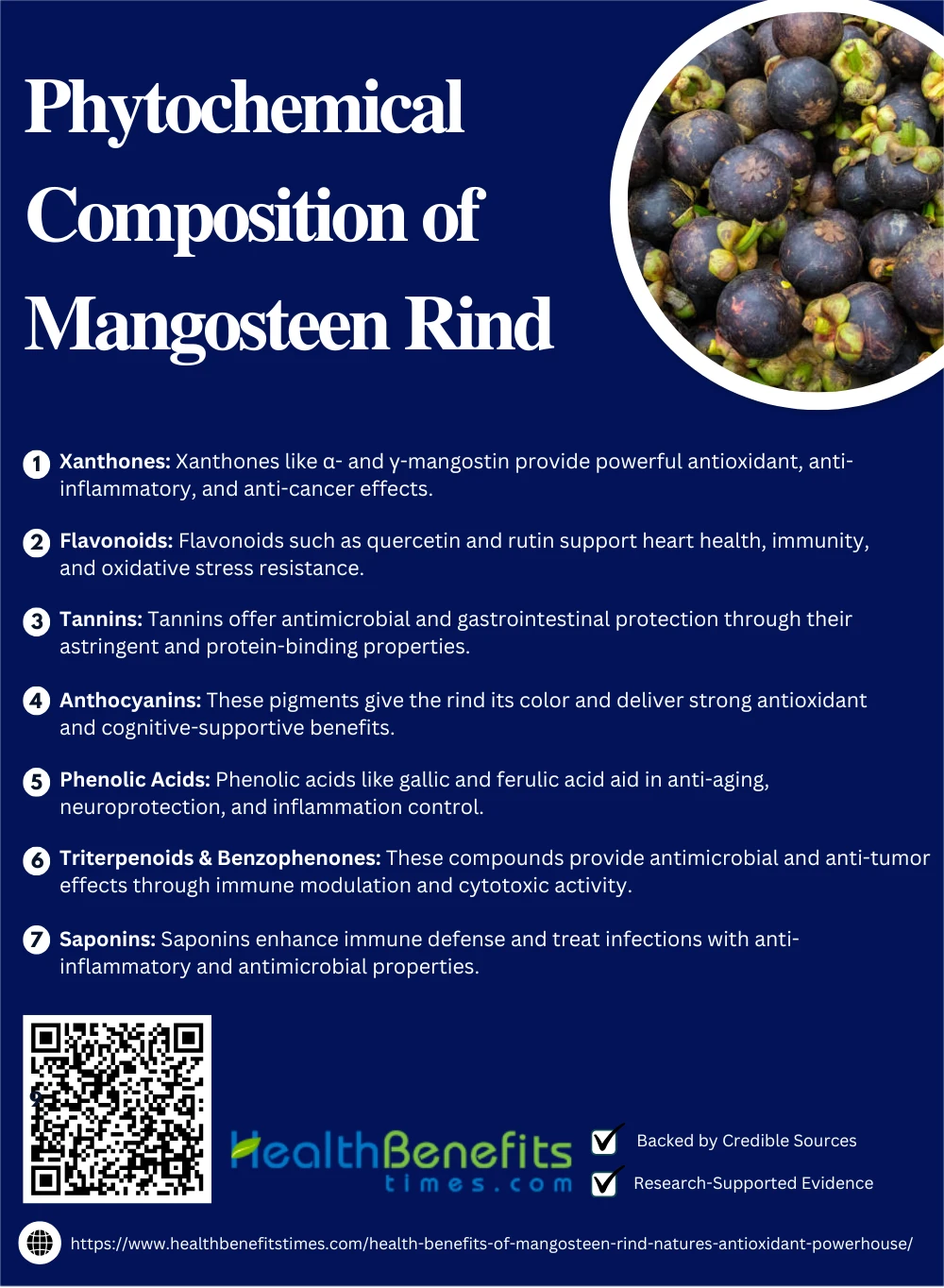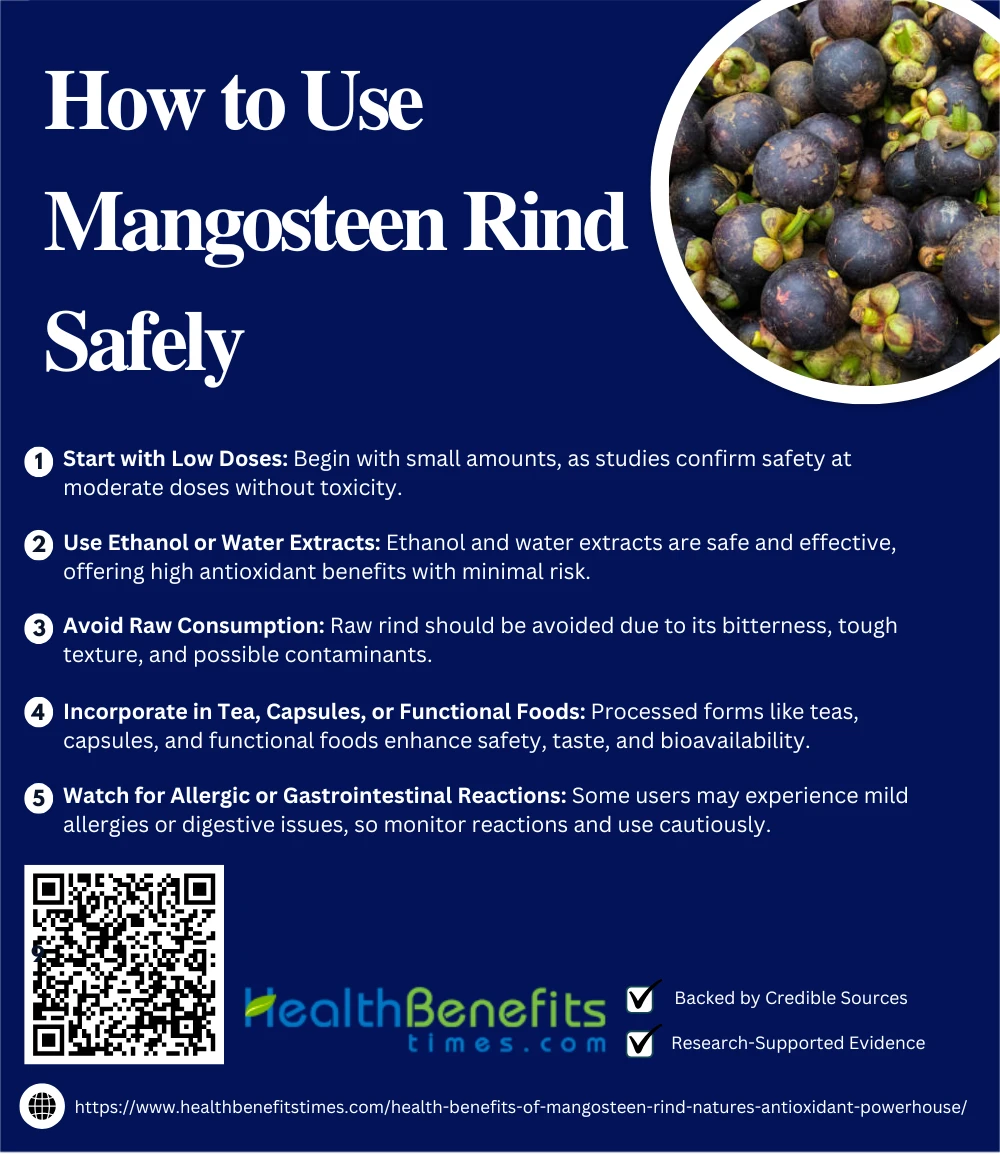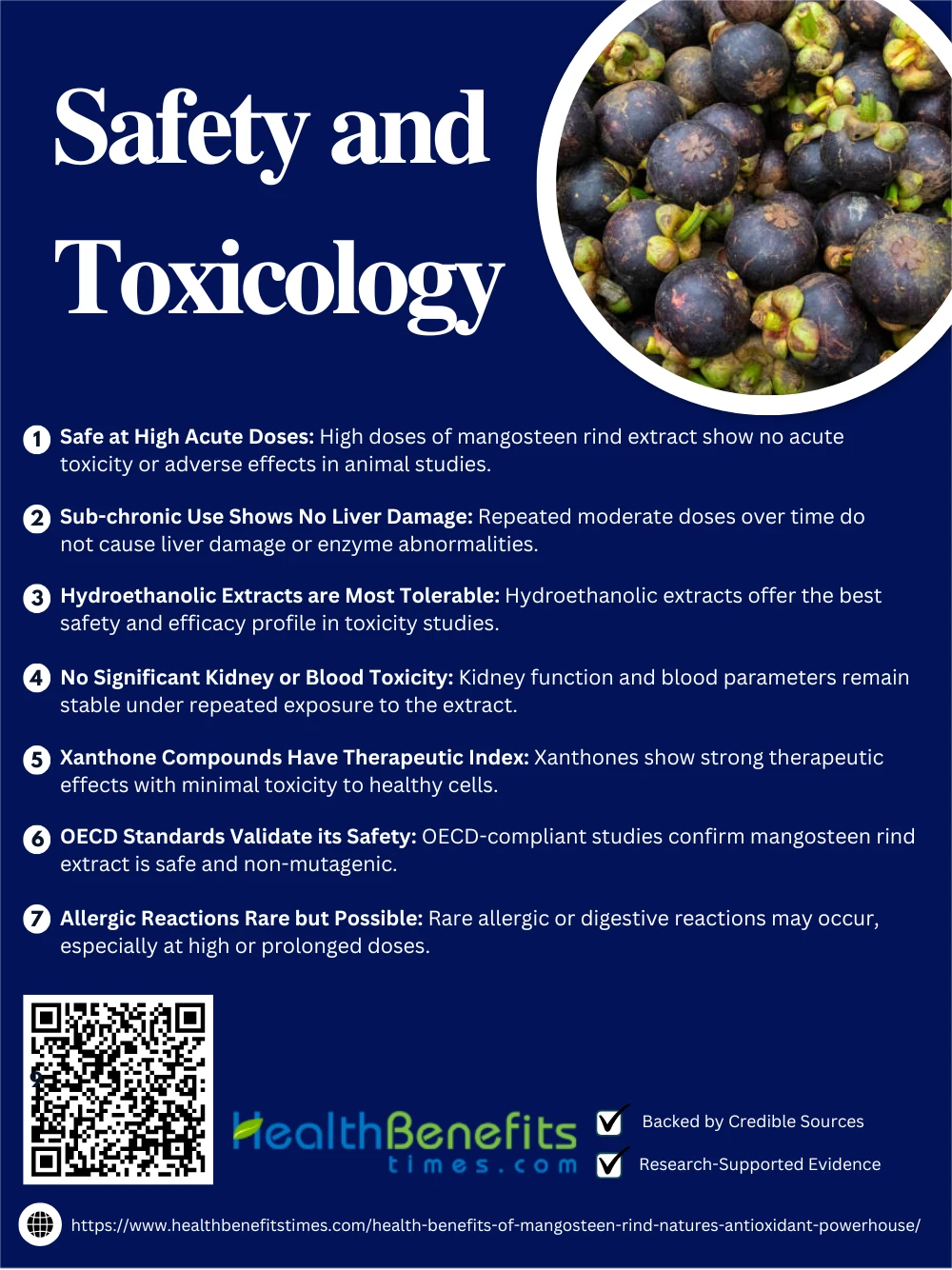- Mangosteen rind is the thick, purple outer layer of the mangosteen fruit, rich in bioactive compounds like xanthones and flavonoids.
- Packed with powerful antioxidants, mangosteen rind helps combat oxidative stress and supports overall health.
- Its anti-inflammatory, anti-diabetic, and antimicrobial properties make it a valuable natural remedy for wellness and disease prevention.
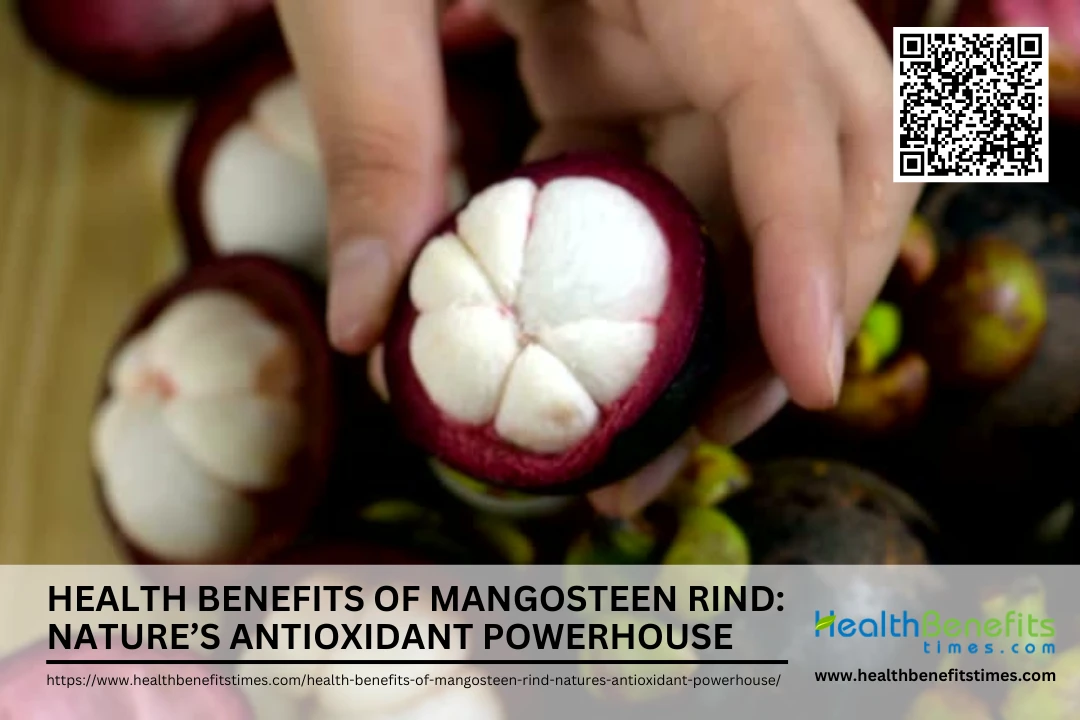 Mangosteen (Garcinia mangostana) is a tropical fruit native to Southeast Asia, known for its juicy white pulp and a thick, purple rind rich in xanthones and polyphenolic compounds. Mangosteen rind, often discarded during consumption, has gained scientific attention for its impressive health benefits—especially its antioxidant capabilities. Rich in bioactive xanthones like α-mangostin and γ-mangostin, the rind plays a crucial role in neutralizing free radicals, reducing oxidative stress, and potentially lowering the risk of chronic illnesses such as cardiovascular diseases and cancer. In recent pharmacological reviews, mangosteen pericarp extract has demonstrated potent anti-inflammatory, anti-diabetic, and antimicrobial effects, owing to its high concentration of natural antioxidants and phenolic content. As researchers continue to validate traditional knowledge through modern science, mangosteen rind emerges as a sustainable, therapeutic agent in functional foods and herbal medicine.
Mangosteen (Garcinia mangostana) is a tropical fruit native to Southeast Asia, known for its juicy white pulp and a thick, purple rind rich in xanthones and polyphenolic compounds. Mangosteen rind, often discarded during consumption, has gained scientific attention for its impressive health benefits—especially its antioxidant capabilities. Rich in bioactive xanthones like α-mangostin and γ-mangostin, the rind plays a crucial role in neutralizing free radicals, reducing oxidative stress, and potentially lowering the risk of chronic illnesses such as cardiovascular diseases and cancer. In recent pharmacological reviews, mangosteen pericarp extract has demonstrated potent anti-inflammatory, anti-diabetic, and antimicrobial effects, owing to its high concentration of natural antioxidants and phenolic content. As researchers continue to validate traditional knowledge through modern science, mangosteen rind emerges as a sustainable, therapeutic agent in functional foods and herbal medicine.
What is Mangosteen Rind?
Mangosteen rind, the thick purple pericarp of the Garcinia mangostana fruit, is often discarded as waste despite being a reservoir of potent bioactive compounds. This outer layer is fibrous and leathery in texture, rich in antioxidant polyphenols, flavonoids, and especially xanthones—compounds known for their therapeutic significance composition and antioxidant profile of mangosteen rind. (1)
Traditionally, the rind has been used for centuries in Southeast Asian herbal medicine to treat skin infections, wounds, diarrhea, and inflammation. Folk remedies often utilized dried mangosteen hulls in decoctions and topical pastes, capitalizing on their natural antimicrobial and anti-inflammatory properties ethnomedicinal uses of mangosteen rind. (2)
Phytochemical studies have identified more than 60 xanthone derivatives in the rind, with α-mangostin being the most prominent. These compounds contribute significantly to its antioxidant, anti-inflammatory, and cytotoxic activities xanthones from mangosteen pericarp. (3)
Differentiation between rind (pericarp), pulp, and seeds
Here’s a detailed comparison table showing the differentiation between the rind (pericarp), pulp, and seeds of Mangosteen (Garcinia mangostana):
| Feature | Rind (Pericarp) | Pulp (Aril) | Seeds |
| Location | Outermost layer of the fruit | Inner flesh surrounding the seeds | Inside the pulp |
| Appearance | Thick, leathery, dark purple when ripe | White, segmented, soft and juicy | Oval, light brown, smooth surface |
| Texture | Tough, fibrous, often woody | Tender, juicy, gelatinous | Hard, slightly slippery |
| Taste | Bitter, astringent | Sweet-tangy and aromatic | Bitter, inedible in raw form |
| Edibility | Non-edible in raw form; used in extracts | Edible; main consumable part of the fruit | Non-edible; sometimes used in research |
| Nutritional Value | Rich in xanthones, flavonoids, tannins, polyphenols | Rich in vitamin C, carbohydrates, fiber | Contains starch, proteins, trace lipids |
| Medicinal Use | Antioxidant, anti-inflammatory, anti-cancer, antimicrobial | Supports immune health, digestive health | Limited research, some seed oil studies |
| Cultural Use | Traditional medicine (skin disorders, diarrhea, inflammation) | Culinary—eaten fresh or in juices and desserts | Mostly discarded or used in plant propagation |
| Processing Use | Used in pharmaceuticals, nutraceuticals, cosmetics | Direct consumption or juice extraction | Rarely used commercially |
Phytochemical Composition of Mangosteen Rind
Mangosteen rind is rich in bioactive compounds, particularly xanthones, flavonoids, and tannins, which contribute to its potent antioxidant, anti-inflammatory, and antimicrobial properties, supporting its use in traditional and modern medicine.
Xanthones are the most abundant and bioactive phytochemicals found in mangosteen rind. These polyphenolic compounds—particularly α-mangostin and γ-mangostin—exhibit strong antioxidant, anti-cancer, anti-inflammatory, and neuroprotective effects. Xanthones work by scavenging free radicals, inhibiting cancer cell proliferation, and modulating inflammatory pathways such as COX-2 inhibition.
2. Flavonoids
Mangosteen rind contains flavonoids such as quercetin, epicatechin, and rutin, known for their cardioprotective, anti-inflammatory, and antioxidant actions. These compounds regulate vascular health, inhibit lipid peroxidation, and enhance cellular resistance to oxidative damage. Flavonoids also support immune modulation and metabolic balance.
3. Tannins
Tannins in mangosteen rind are astringent polyphenols that have been traditionally used to manage diarrhea, infections, and wound healing. These compounds form complexes with proteins and microbes, contributing to antimicrobial action and gastrointestinal protection.
4. Anthocyanins
These water-soluble pigments are responsible for the deep purple color of the rind and possess strong antioxidant and anti-inflammatory capacities. Anthocyanins protect against cellular damage, reduce oxidative stress, and may also support cognitive health and visual acuity.
5. Phenolic Acids
Phenolic acids such as gallic acid and ferulic acid are present in the rind and contribute to neuroprotection, anti-aging, and anti-inflammatory effects. These compounds modulate enzymes linked to inflammation and aging, while also stabilizing cell membranes.
6. Triterpenoids & Benzophenones
Though less concentrated than xanthones, these compounds show antimicrobial, antioxidant, and anti-tumor properties. They modulate immune pathways and exhibit cytotoxicity against certain cancer cells.
7. Saponins
Saponins have surfactant-like properties and are recognized for their immune-boosting, anti-inflammatory, and anti-microbial roles. In mangosteen rind, they contribute to traditional healing effects in skin infections and digestive issues.
Health Benefits of Mangosteen Rind
Mangosteen rind offers numerous health benefits due to its rich antioxidant and anti-inflammatory properties. It supports immunity, fights infections, promotes skin health, and may help prevent chronic diseases like cancer.
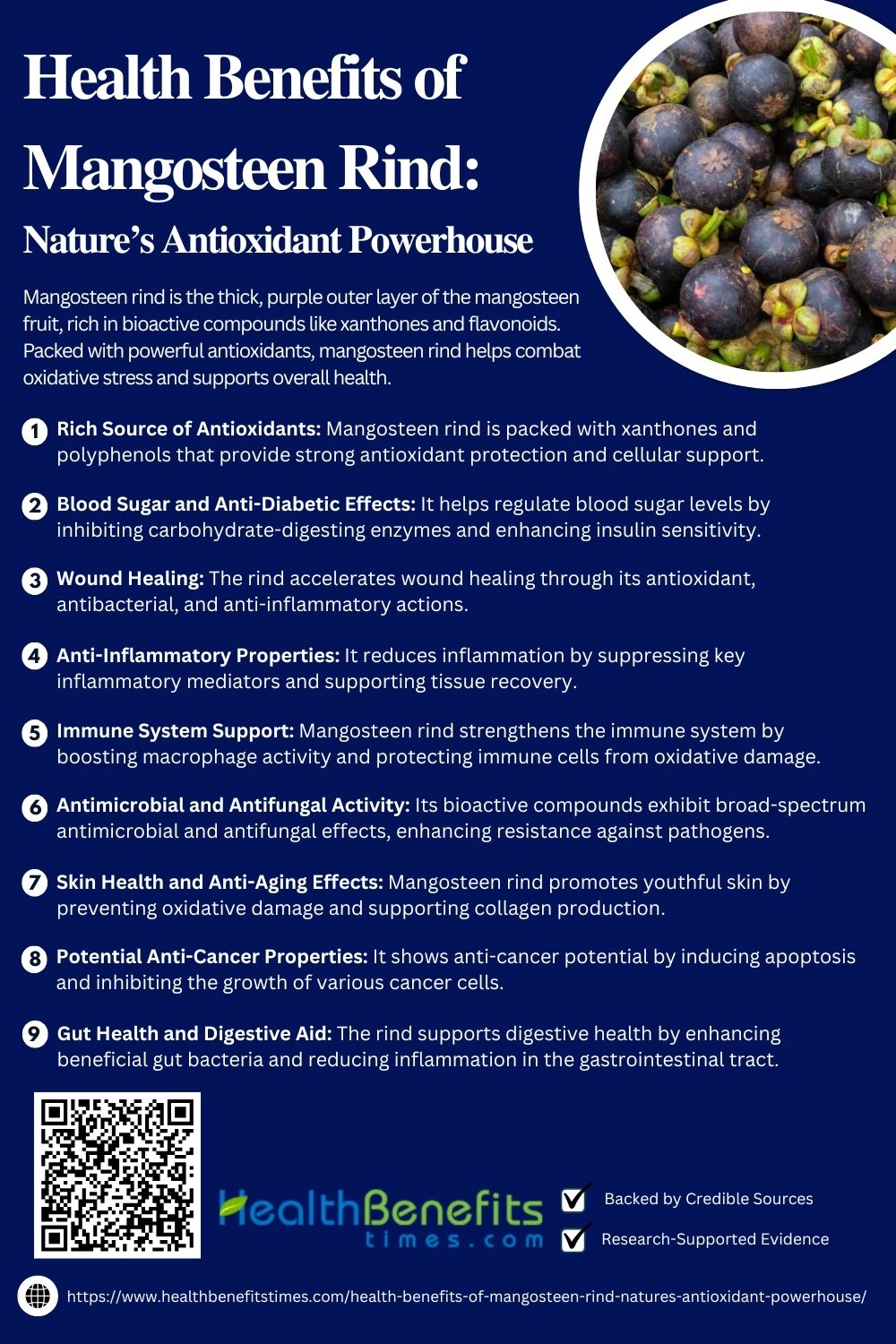 1. Rich Source of Antioxidants
1. Rich Source of Antioxidants
Mangosteen rind is a potent antioxidant source, primarily due to its high xanthone content. Studies show that compounds like α-mangostin exhibit superior radical-scavenging activity, contributing to cellular protection and reduced oxidative stress. (4) Antioxidant-rich extracts from the rind have demonstrated neuroprotective effects. (5) Additionally, polyphenolic richness enhances its efficacy, and it has shown hepatoprotective effects in vivo. (6) (7) Further analysis supports its stability as an antioxidant supplement. (8)
2. Blood Sugar and Anti-Diabetic Effects
Mangosteen rind shows promising anti-diabetic properties through enzyme inhibition and insulin sensitivity enhancement. α- and γ-mangostin inhibit α-glucosidase and α-amylase, reducing glucose absorption. (6) Experimental studies confirm reduced blood glucose in diabetic rats. (9) Another study highlights its effectiveness in controlling glucose via jelly candy format. (10) Recent reviews confirm clinical potential for glycemic management. (11)
3. Wound Healing
Mangosteen rind has shown significant promise in promoting wound healing due to its antioxidant and antibacterial properties. It accelerates epithelialization and collagen deposition, essential for tissue regeneration, as observed in diabetic wound models. (12) The presence of xanthones enhances angiogenesis and fibroblast activity. ({% https://synapse.koreamed.org/articles/1060610 trusted %}) Clinical trials further validate improved healing in chronic periodontitis. (13) Anti-inflammatory effects reduce tissue irritation, while antimicrobial action prevents secondary infections. (14) (2)
4. Anti-Inflammatory Properties
Mangosteen rind extract demonstrates potent anti-inflammatory effects, primarily through suppression of pro-inflammatory mediators like TNF-α and IL-6. (15) In vivo models have confirmed its efficacy in reducing carrageenan-induced edema. (16) Additionally, clinical use in oral diseases showed decreased inflammation in gingival tissues. (17) Studies also highlight its role in modulating chronic inflammation in periodontitis and systemic inflammation post-exercise. (18) (19)
5. Immune System Support
Mangosteen rind has been shown to significantly bolster the immune system due to its rich content of xanthones, polysaccharides, and polyphenols. Studies suggest these bioactives enhance macrophage function and reduce oxidative stress, key in regulating immune responses. (20) Furthermore, its antioxidant properties protect immune cells from damage. (21) Research also indicates that mangosteen can modulate cytokine expression, stimulate natural killer cell activity, and improve T-cell function. (22) (23) (24)
6. Antimicrobial and Antifungal Activity
Mangosteen rind contains xanthones such as α-mangostin, which possess broad-spectrum antimicrobial properties. It has demonstrated potent activity against Escherichia coli and Staphylococcus aureus. (25) Its antifungal effects are particularly effective against Candida albicans. (26) The rind’s polyphenols also inhibit microbial resistance pathways. (27) Studies show that fermented peel enhances antimicrobial potency and synergizes with commercial antibiotics. (28) (29)
7. Skin Health and Anti-Aging Effects
Mangosteen rind is gaining recognition for its skin-enhancing and anti-aging properties due to its rich content of xanthones and antioxidants. These compounds help protect the skin from oxidative damage, delay the formation of wrinkles, and promote collagen synthesis. (5) Its phenolic profile exhibits potent inhibition of elastase and collagenase, enzymes that degrade skin structure. (30) Studies also show it promotes skin cell regeneration and wound healing. (31) In cosmetics, mangosteen extract improves moisture retention and dermal texture. (32) Furthermore, mangosteen vinegar has shown promising antimicrobial activity that supports skin barrier function. (33)
8. Potential Anti-Cancer Properties
Mangosteen rind contains powerful xanthones such as α-mangostin, which exhibit cytotoxic effects against multiple cancer cell lines, including breast and liver cancers. (34) These xanthones trigger apoptosis and suppress tumor cell proliferation. (35) Mangostanin and related compounds target oxidative pathways linked to tumor growth. (36) Additional studies confirm its multi-target chemopreventive potential and dual inhibition of cancer-related enzymes. (37) (38)
9. Gut Health and Digestive Aid
Mangosteen rind plays a key role in enhancing digestive health and gut microbiota through its prebiotic properties. It supports the growth of beneficial bacteria like Lactobacillus acidophilus, improving nutrient absorption and gut integrity. (39) Extracts rich in polyphenols promote microbial diversity and stimulate fermentation in the colon. (40) Its antimicrobial and anti-inflammatory activities make it effective against gastrointestinal pathogens. (41) Moreover, dietary supplementation with mangosteen peel improves intestinal histology and enzyme activity in animal studies. (42) Additionally, it has been shown to reduce intestinal permeability and oxidative stress, boosting overall digestive efficiency. (43)
How to Use Mangosteen Rind Safely
Using mangosteen rind safely involves proper preparation methods like drying, powdering, or brewing as tea. Recommended dosages, potential side effects, and consultation with healthcare providers are essential for safe use.
To ensure safety, begin with low doses of mangosteen rind. Animal studies confirm that up to 5000 mg/kg is non-toxic. (44) Subchronic evaluations show no liver damage at moderate doses. (45) Repeated-dose studies also report safe outcomes without toxicity in rats. (46)
2. Use Ethanol or Water Extracts
Ethanol and water-based extracts are safest for human consumption, offering high antioxidant recovery with minimal toxicity. (47) Toxicological data supports ethanol extracts for long-term use in preclinical models. (48) Additionally, hydroethanolic extracts show favorable safety in OECD-guided toxicity studies. (49)
3. Avoid Raw Consumption
Avoid consuming mangosteen rind raw due to its tough texture, bitter taste, and potential pesticide residues. (50) Proper preparation like drying or boiling improves digestibility and safety. (51) Processing also enhances nutrient release while eliminating microbial contaminants. (52)
4. Incorporate in Tea, Capsules, or Functional Foods
Mangosteen rind can be safely used by incorporating it into teas, capsules, or jelly forms which preserve its bioactivity and reduce bitterness. (32) Functional foods like fermented beverages or herbal candy also improve palatability. (53) Capsule formulations have shown controlled dosage and improved antioxidant delivery. (48)
5. Watch for Allergic or Gastrointestinal Reactions
Although generally safe, mangosteen rind may cause gastrointestinal disturbances or rare allergic reactions in sensitive individuals. Animal studies showed no liver or gut toxicity at normal doses. (49) Still, histamine-mediated allergies and dermatitis have been observed in some cases. Preliminary human data advise caution, especially in long-term use. (44)
Safety and Toxicology
Understanding the safety and toxicology of mangosteen rind is crucial, as improper use or high doses may cause adverse effects. Scientific evaluation ensures its benefits outweigh potential health risks.
Mangosteen rind extract demonstrates excellent safety in acute toxicity studies. Doses up to 5000 mg/kg caused no mortality or behavioral changes in rats. (44) OECD-guided trials confirmed this safety profile. (49) Another study also reported non-toxic responses at similar dosages. (54)
2. Sub-chronic Use Shows No Liver Damage
Subchronic use of mangosteen rind extract has not resulted in liver damage, even after 28-day repeated doses in Wistar rats. (46) Histological liver assessments remained normal. (45) Additionally, liver enzymes stayed within physiological ranges, indicating hepatic safety. (55)
3. Hydroethanolic Extracts are Most Tolerable
Hydroethanolic extracts of mangosteen rind are widely recognized for their safety and efficacy in both acute and subchronic models. Studies show no observed toxicity or mortality at therapeutic levels. (54) These extracts are also well-tolerated in antioxidant-focused trials. (47) In vivo data further validate their use in nutraceuticals. (49)
4. No Significant Kidney or Blood Toxicity
Repeated-dose toxicity studies reveal no adverse impact of mangosteen rind extract on kidney morphology or blood biochemistry. (46) Hematological parameters remained stable even under subchronic exposure. (55) Another long-term evaluation confirmed its non-toxic renal profile in rodent models. (45)
5. Xanthone Compounds Have Therapeutic Index
Xanthones in mangosteen rind, especially α-mangostin, have demonstrated significant therapeutic potential without exceeding toxic thresholds. Preclinical studies show selective cytotoxicity against cancer cells with minimal harm to healthy tissues. (36) Their pharmacokinetics support safe dosing ranges (Gutierrez-Orozco & Failla, 2013). Subchronic studies in rats further confirm a wide safety margin. (45)
6. OECD Standards Validate its Safety
Mangosteen rind extract complies with OECD toxicity testing protocols, confirming it as non-toxic in both acute and subchronic exposures. (49) Validations include no observed genotoxic, mutagenic, or teratogenic effects. (44) In-silico simulations also affirm long-term safety and biological compatibility. (47)
7. Allergic Reactions Rare but Possible
Though rare, allergic or gastrointestinal side effects from mangosteen rind may occur, especially with prolonged or high-dose intake. (44) Documented cases include mild skin irritation and histamine reactions in topical and oral applications. (36) Clinical trials recommend caution in sensitive individuals. (56)
Conclusion
Mangosteen rind stands out as a remarkable natural remedy, offering a wide range of health benefits rooted in its rich antioxidant and anti-inflammatory properties. From supporting immune function and promoting skin health to combating harmful microbes and potentially preventing chronic diseases, the rind of this tropical fruit is a true powerhouse of wellness. Its potent phytochemicals, especially xanthones, make it a valuable addition to both traditional and modern health practices. While research continues to uncover more benefits, incorporating mangosteen rind into your wellness routine—when done safely—can be a natural and effective way to enhance your overall health and vitality.



